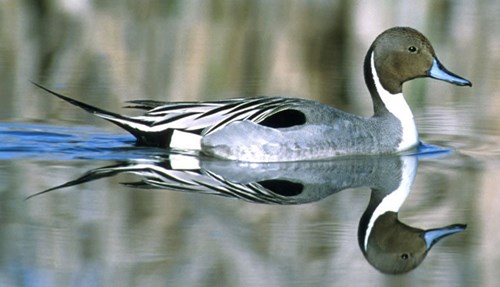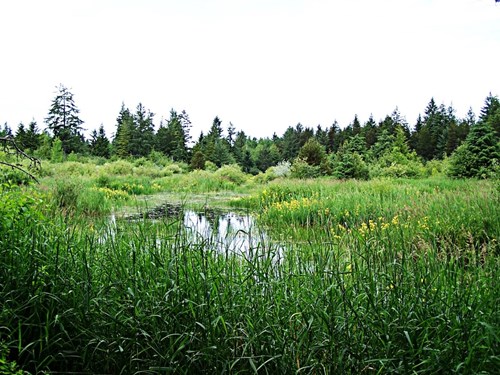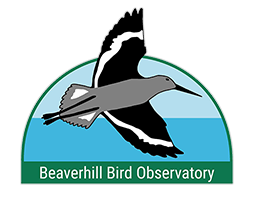Drought: What Can We Do?
Monday, December 4, 2017Alberta contains a wide variety of landscapes that can be affected by drought in different ways. Our broad scale landscapes include mountains, foothills, boreal forest, grassland, and parkland. Many small, often temporary water bodies are scattered throughout the province, even though Alberta is naturally a relatively dry province, characterized by low levels of precipitation. We can expect climate change to modify the water balance and lead to extended and more frequent periods of drought. What is drought? It is a long period of low rainfall and shortage of water.
How does drought affect birds?
The many wetlands we have in Alberta are a great source of food and shelter for birds. Songbirds rely on an abundance of insects in wetlands, grasslands, and in the aspen and boreal forests to raise their young. Waterfowl take shelter and eat vegetation from wetlands. Also, some waterfowl and raptors catch and eat fish. Wetlands are shrinking in size due to climate change, which in turn, is reducing the habitat available for birds as well as the amount of food that they can eat. Droughts also impact grassland birds, with heat stress and declining availability of food causing them to abandon nests, resulting in reduced productivity. We will discuss more about the impacts of drought on grassland birds in upcoming weeks.
Just how important are wetlands to breeding birds? Let’s use the Northern Pintail as an example. Northern Pintails are a species that nest on the ground, and then lead their young to water once they have hatched, to reduce the risk of predation and so the young can get food. Pintails rely heavily on these wetlands for food and for safety from predators once the young have hatched and can swim. One study found that in years when precipitation on the prairies was low, Pintails had to find other areas to breed in, and were displaced to less ideal habitat in the Boreal Forest and Arctic. Once displaced, fewer ducks found nesting sites and those that did produced fewer nestlings in these northern landscapes. This is significant because since 1966, Northern Pintail populations have dropped by 72%.
But it is not only one species that is affected by drought here in Alberta. The Beaverhill Bird Observatory, located an hour’s drive east of Edmonton, is located beside the Beaverhill Lake. Historically, this lake was 139km2, and in its history 145 species of birds have been found breeding there. In particular, Beaverhill Lake contained two islands important for nesting pelican and cormorants. These birds nest on the ground, on the shore of the lake. By nesting on islands, they were safe from predators such as coyotes, that don’t often swim to find their prey. Due to a multi-year drought, this huge water body completely dried up by 2005. All of that protected nesting habitat for American White Pelicans and cormorants was lost.
The Beaverhill Lake was not only important for nesting birds either! Beaverhill Lake was internationally known for the Snow Goose Festival in April.  When the lake was full of water, thousands of Snow Geese could be found at any one time on the vast open water of the lake. It provided what we call a staging ground; a site where thousands of shorebirds and waterfowl could stop during migration to find food before they continue on their journey. With the drying of the lake, that important habitat was lost. The thousands of shorebirds that relied on the mudflats, and the thousands of ducks and geese that depended on the shallow water, now had to disperse to other water bodies, which were also decreasing in size and number as well. Some species of shorebirds fly thousands of kilometers from their breeding grounds in the arctic to wintering grounds in the south and if they run out of places to stop and refuel, they will be in critical danger of becoming extinct. Up to 270 different species of birds have been recorded on or near Beaverhill Lake. The loss of this waterbody has huge ramifications for bird conservation.
When the lake was full of water, thousands of Snow Geese could be found at any one time on the vast open water of the lake. It provided what we call a staging ground; a site where thousands of shorebirds and waterfowl could stop during migration to find food before they continue on their journey. With the drying of the lake, that important habitat was lost. The thousands of shorebirds that relied on the mudflats, and the thousands of ducks and geese that depended on the shallow water, now had to disperse to other water bodies, which were also decreasing in size and number as well. Some species of shorebirds fly thousands of kilometers from their breeding grounds in the arctic to wintering grounds in the south and if they run out of places to stop and refuel, they will be in critical danger of becoming extinct. Up to 270 different species of birds have been recorded on or near Beaverhill Lake. The loss of this waterbody has huge ramifications for bird conservation.
Long Term Effects
Strangely enough, severe drought can eventually contribute to flooding as well! When the water table (level of water in the ground) is lowered for a long time, the soil can compress, and remove the spaces that formerly held water. When more water occurs in the area again, the soil can no longer hold as much water, and the excess must run along the surface, which promotes flooding. Unfortunately, flooding also negatively impacts many of our bird species.
What Can We Do?
There are two types of actions. We can mitigate the effects of drought and adapt to it, and we can take action to slow the cause, climate change.
- We can mitigate the effects of drought by building structures and planning ecosystems that retain moisture. One example is planting trees. Trees retain more moisture from snowfall from the winter into the spring and summer. We can also keep more of our water in the environment by using less water for residential and industrial uses. Changing agricultural practices can also help reduce the impacts of drought. We can use different harvest methods such as no tilling of the soil, or use more efficient harvest equipment. This allows the environment to retain more water and reduces the impacts of drought on birds.
-
One action you can take to slow climate change individually, with significant effect is to consider the frequency of your meat and dairy consumption and the type of meats consumed. A study found that if all Americans were to replace beef with beans today, while not changing their consumption of other animal products, they could almost meet their carbon emission reduction goals immediately. Not all meat has the same environmental impact; chickens have a lower carbon footprint than beef, for example, and range fed cows sustain native grasslands with benefits to some of our most endangered birds. Eating wild game and fish that is harvested sustainably also reduces your carbon foot print. You can make a difference- consider other options apart from intensive meat production!
Photo Credit:
Northern Pintail Photo by United States Fish and Wildlife Service. Unknown Date. https://commons.wikimedia.org/w/index.php?curid=679017
By Liam M. Higgins - Own work. Taken with Kodak Z740 Zoom Digital Camera, Copyrighted free use, https://commons.wikimedia.org/w/index.php?curid=876501
Drought photo by Tomas Castelazo. Date unknown. https://commons.wikimedia.org/wiki/File:Drought.jpg
Additional Reading:
Calverley, B. K., and Boag, D. A. 1977. Reproductive potential in parkland- and arctic-nesting populations of mallards and pintails (Anatidae). Canadian Journal of Zoology 55(8): 1242-1251,
https://doi.org/10.1139/z77-163 Climate in Alberta. 2017. Alberta Water Portal Society. Retrieved on November 24, 2017 from https://albertawater.com/virtualwaterflows/climate-in-alberta
Dai, A., K.E. Trenberth, and T. Qian. 2004. A Global Dataset of Palmer Drought Severity Index for 1870–2002: Relationship with Soil Moisture and Effects of Surface Warming. Journal of Hydrometeorology 2004 5:6, 1117-1130. Doi: https://doi.org/10.1175/JHM-386.1
George, T. L., Fowler, A. C., Knight R. L., McEwen, L. C. 1992. Impacts of a Severe Drought on Grassland Birds in Western North Dakota. Ecological Applications 2(3):275-284
IPCC, 2014: Climate Change 2014: Synthesis Report. Contribution of Working Groups I, II and III to the Fifth Assessment Report of the Intergovernmental Panel on Climate Change [Core Writing Team, R.K. Pachauri and L.A. Meyer (eds.)]. IPCC, Geneva, Switzerland, 151 pp.
Palmer, W. C. 1965. Meteorological Drought. U.S. Department of Commerce, Research Paper no. 45. Sowerby, A., Emmett, B. A., Tietema, A., and Beier, C. 2008. Contrasting effects of repeated summer drought on soil carbon efflux in hydric and mesic heathland soils. Global Change Biology, 14: 2388–2404. doi:10.1111/j.1365-2486.2008.01643.x
Tait, C. 2017. In the face of drought Canadian farmers adjust to a changing climate. The Globe and Mail. Retrieved on November 24, 2017 from: https://beta.theglobeandmail.com/news/alberta/in-the-face-ofdrought-canadian-farmers-adjust-to-achangingclimate/article36220413/?ref=http://www.theglobeandmail.com&
%MCEPASTEBIN%
Blog Posts
- What is Climate Change
- Drought: What Can We Do?
- Migration and Climate Change; a Complicated Relationship (Part 1)
- Migration and Climate Change; a Complicated Relationship (Part 2)
- Climate Change and Birds’ Resources
- Ladder to Extinction
- Arctic Warming and Ecosystem Impacts
- Climate Change Connection to Mountain Pine Beetle
- Tackling Climate Change Denialism
- Impact of Climate Change on Bluebirds
- An Introduction to Climate Change
- Great Decline of Aerial Insectivores
- Role of Oceans in Fighting Climate Change
- Role Of Forests In Fighting Climate Change
- Impact of Climate Change on Shorebirds
- Impact of Hurricanes and Climate Change on Birds
- An Introduction to Climate Change.
- Impact of Forest Fires, and Climate Change on the Nature
- Impacts of Climate Change on Owls
- Impacts of Climate Change on Birds of Prey
- Whitebark Pine and Clark's Nutcracker
- COVID 19 & The Environment
- Impact of Global Warming on Bird Anatomy and Colour Polymorphism
- Climate Change & West Nile Virus
- All Posts

